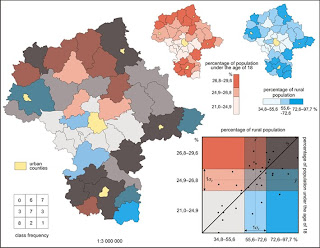
Univariate Choropleth Map is a chloropleth map where only one set of data is displayed.
This map shows poverty levels in the US.







 http://www.cyber-wit.com/images/gallery/histogram1_b.png
http://www.cyber-wit.com/images/gallery/histogram1_b.png



 Infrared Aerial Photos can show differences in land coverings. The one above is of Delta National Park. It can be used as a tool, to show changes in the environment, damaged structures, the health of the environment, and muchmore.
Infrared Aerial Photos can show differences in land coverings. The one above is of Delta National Park. It can be used as a tool, to show changes in the environment, damaged structures, the health of the environment, and muchmore.  It allows the reader to have a "big picture" take on the values represented.
It allows the reader to have a "big picture" take on the values represented.
 A flowmap can be used to show movement of just about anything, both tangible or intangible
A flowmap can be used to show movement of just about anything, both tangible or intangible A proportional circle map uses circles that are portioned out to represent a quantity. It is a visual aid that organizes information so it is fast and easy to portray the idea to the reader. This circle map reveals how each industry in Germany is proportioned out.
A proportional circle map uses circles that are portioned out to represent a quantity. It is a visual aid that organizes information so it is fast and easy to portray the idea to the reader. This circle map reveals how each industry in Germany is proportioned out. 




 nce.
nce. 

http://belcherzoning.com/BZC%20Archives/images/planimetricArea-lg.gif
